Tuesday 30 January 2024
Wat Chedi Luang
Wat Chedi Luang is an old and historically important Buddhist temple in Chiang Mai.
Wat Chedi Luang History
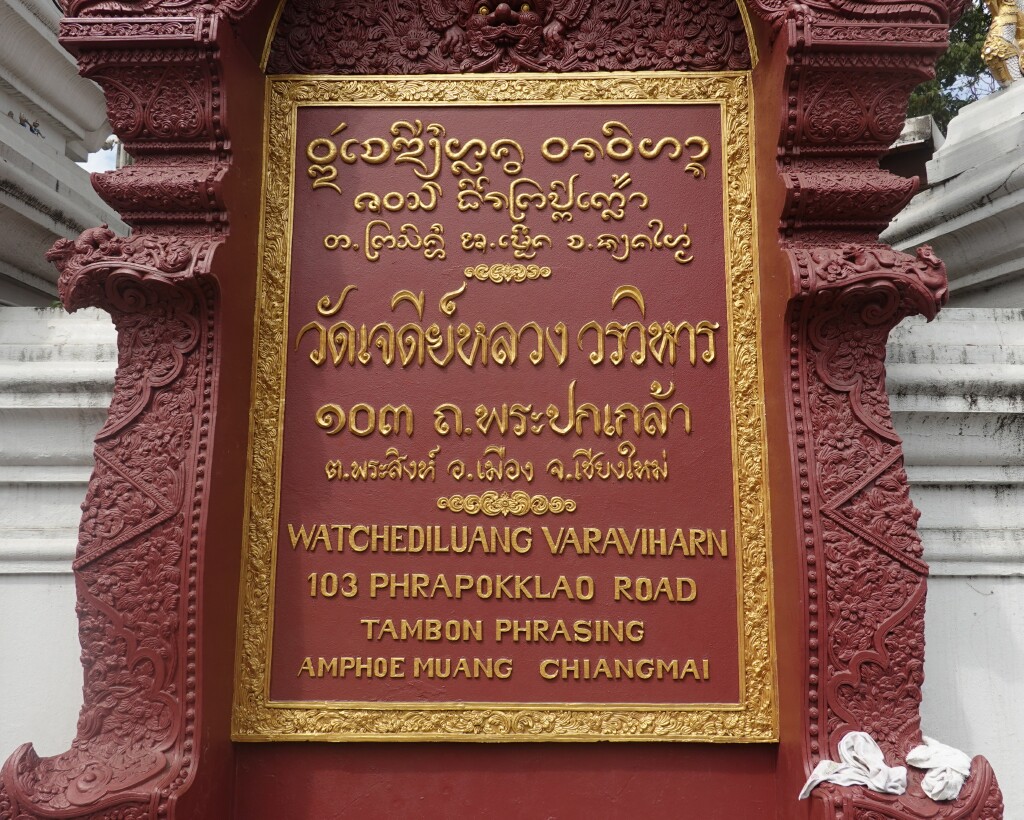
The construction of Wat Chedi Luang began in 1391 by King Saen Muang Ma to hold his father’s ashes. The chedi was not completed until 1475, much of its completion was managed by King Saen Muang Ma’s wife, the queen after the king passed away. It was finally completed under the reign of Kine Tilokarat, who made significant temple improvements at many temples in Chiang Mai.
For nearly 500 years, the spectacular chedi at 82 meters high (270 feet) was the tallest structure in the region and could be seen from miles or kilometers away. For many years, the famous Emerald Buddha sat in the eastern niche of the chedi. [The Emerald Buddha is so named for its color, it was carved from a single piece of dark green jasper.] In 1545 a severe earthquake partly destroyed the upper 30 meters (98 feet) of the chedi and most of the elephant statues along the sides. After the earthquake, the Emerald Buddha was moved to Lamphun, and then to Bangkok where it sits today in Wat Phrae Kaew on the grounds of the Grand Palace.
The grounds of Wat Chedi Luang are extensive as it was originally three different temples that over time merged together.
My Minor Frustration with Wat Chedi Luang
For the first five winter visits to Chiang Mai, I walked across Prapokkloa Road from The 3-Sis to Wat Chedi Luang to sit by the large chedi for my morning meditation. Then, a separate “foreigner” entrance was built and foreigners must now pay 50 baht (~$1.50) to enter the grounds. Since the foreigner entrance was opened, I seldom visit Wat Chedi Luang for my morning meditation.
My second frustration is that the viharn (prayer or worship hall) has been closed and under construction for more than two years, spanning my previous two and this visit. A significant reason for many to visit Wat Chedi Luang is the grand and elegant viharn with the historically significant Phra Chat Attarat standing Buddha statue (translates to “Eighteen-cubit Buddha”), more than 5 meters high (16 feet). The notice at the entrance said “This is the most beautiful Buddha image in the Lanna Kingdom … made with the art of Lanna and Pala, India.” With one of the main features of the temple being unavailable, why is the charge for foreigners still enforced?
Foreigner Entrance
Prapokkloa Road is always busy making it almost impossible to get an unobstructed photo of the relatively new foreigner entrance. Being only seven years old, it is already looking worn and in need of an uplift.
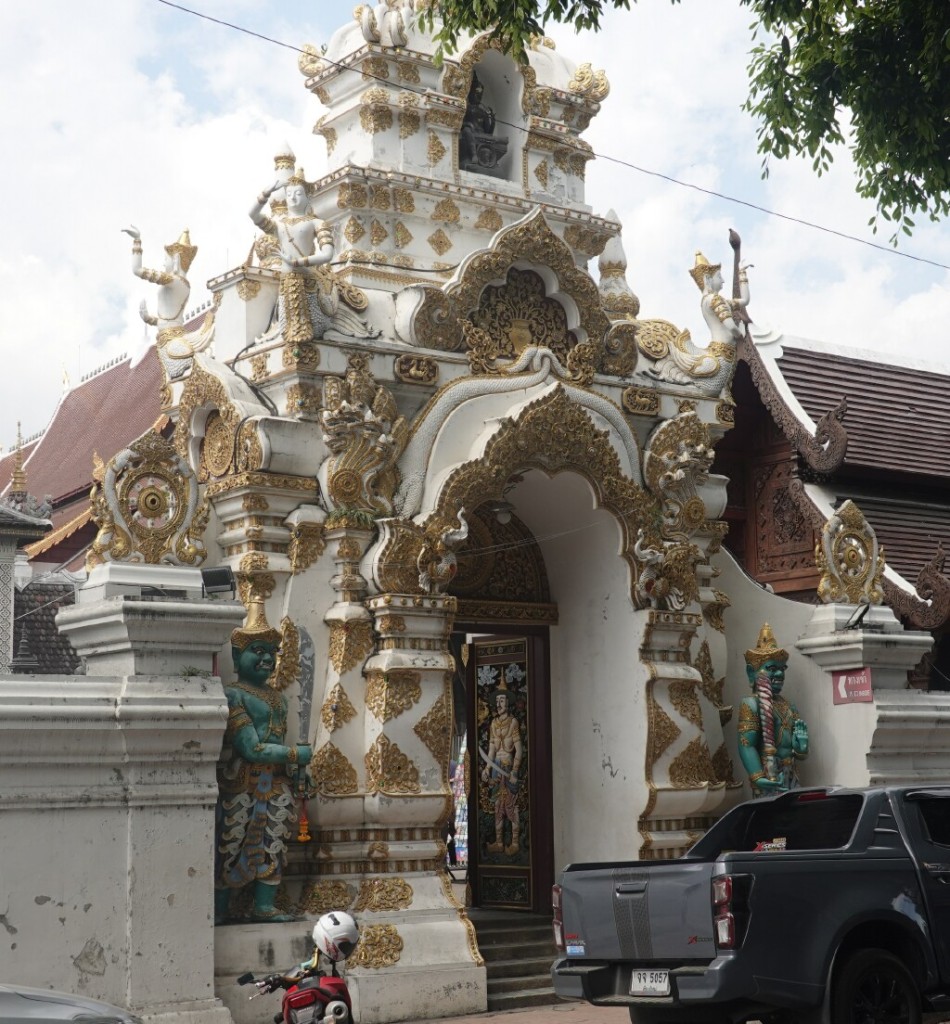
Phra Viharn Luang
Inside (after paying 50 baht), I made my way to the Phra Viharn Luang to see the progress of the construction. Peering inside between the construction fencing, there is much construction still taking place inside and it seems it may be many months or longer before the viharn will be open.
The Phra Viharn Luang has been rebuilt several times (as is common at Buddhist temples). The current building dates from 1929, sitting on the site of the original viharn built in 1412 by the Queen Mother of King Sam Fang Kaen who also cast the standing Phra Chat Attarat Buddha.
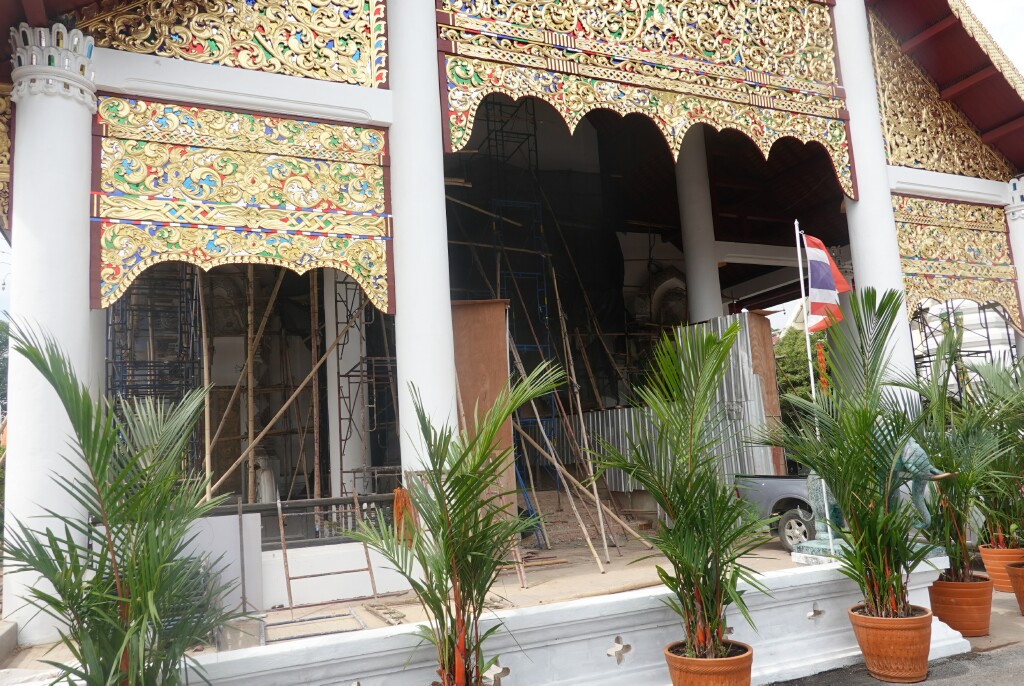
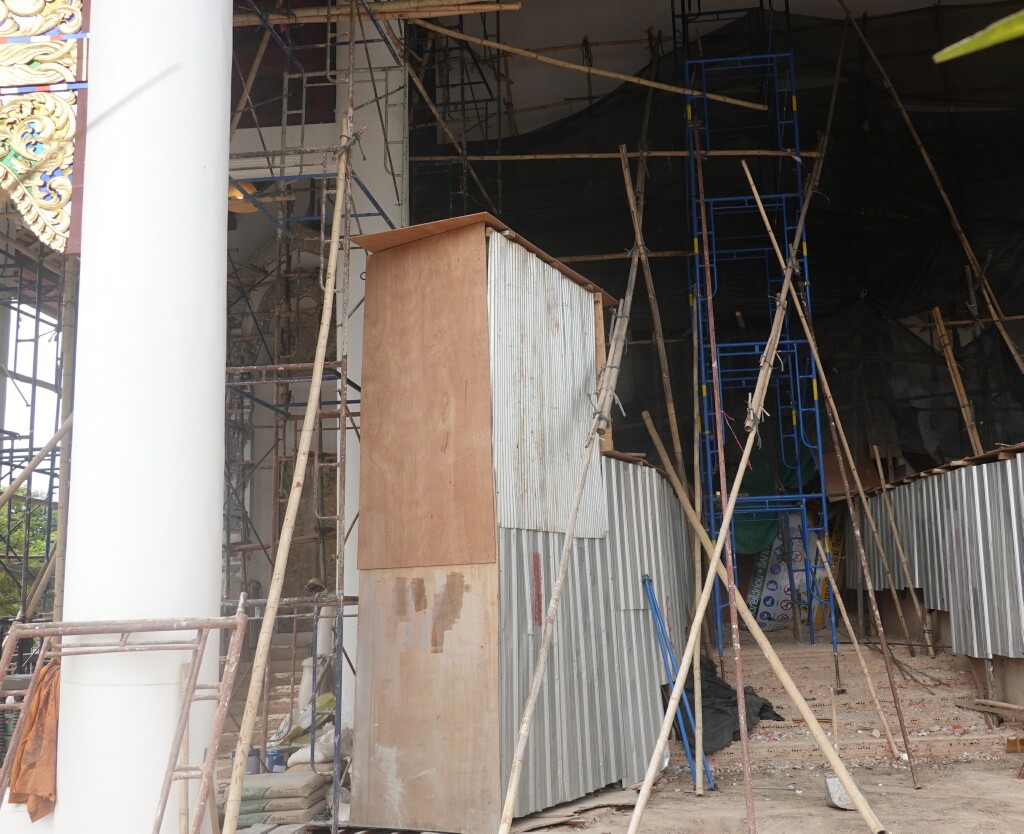
Chiang Mai City Pillar
The Sao Inthakin or city pillar, dates from pre-Lanna kingdom times and was built by the people to protect the city. Every year, the Inthakin Festival is held at which offerings are made to the city pillar, and significant Buddha images from various temples are taken out and displayed (see my recent post “Prapokkloa Road Temples 4 – Wat Chang Taem”). The Sao Inthakin was moved to Wat Chedi Luang in 1800 from Wat Sadeu Muang near the Monument to the Three Kings. The pavilion holding the city pillar was relatively recently rebuilt and as I walked by the viharn towards the large chedi, I took a photo of the small south chedi with the Sao Inthakin pavilion in the background.
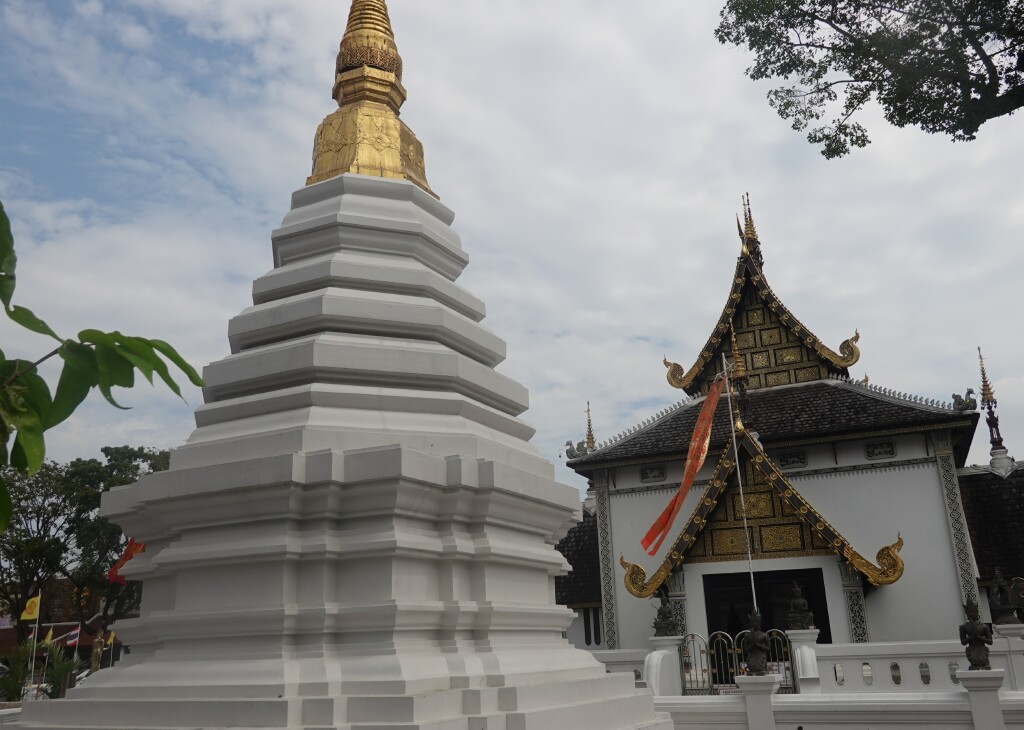
Walking by the viharn, the scaffolding and construction fencing has been removed revealing a nearly completed south side of the viharn with the large chedi on the left side.
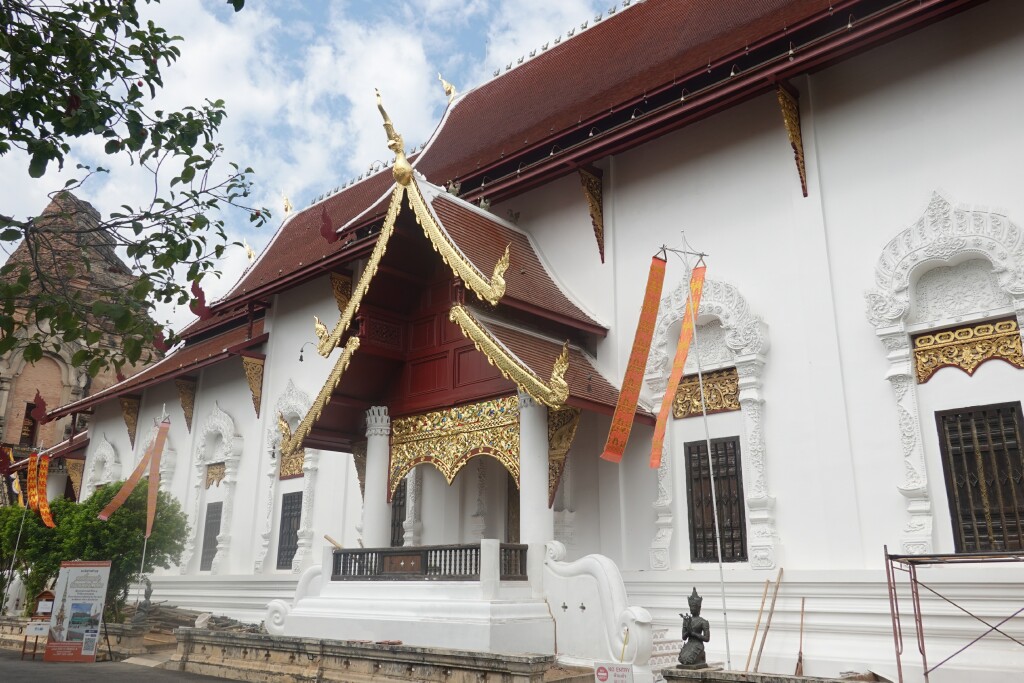
Something I had not seen before were these two gongs, each about 2 meters in diameter. They appear to have been placed recently. It is unclear whether these will remain or are a temporary addition for a celebration, event, or ritual. The frames being held at the base by bricks appears temporary.
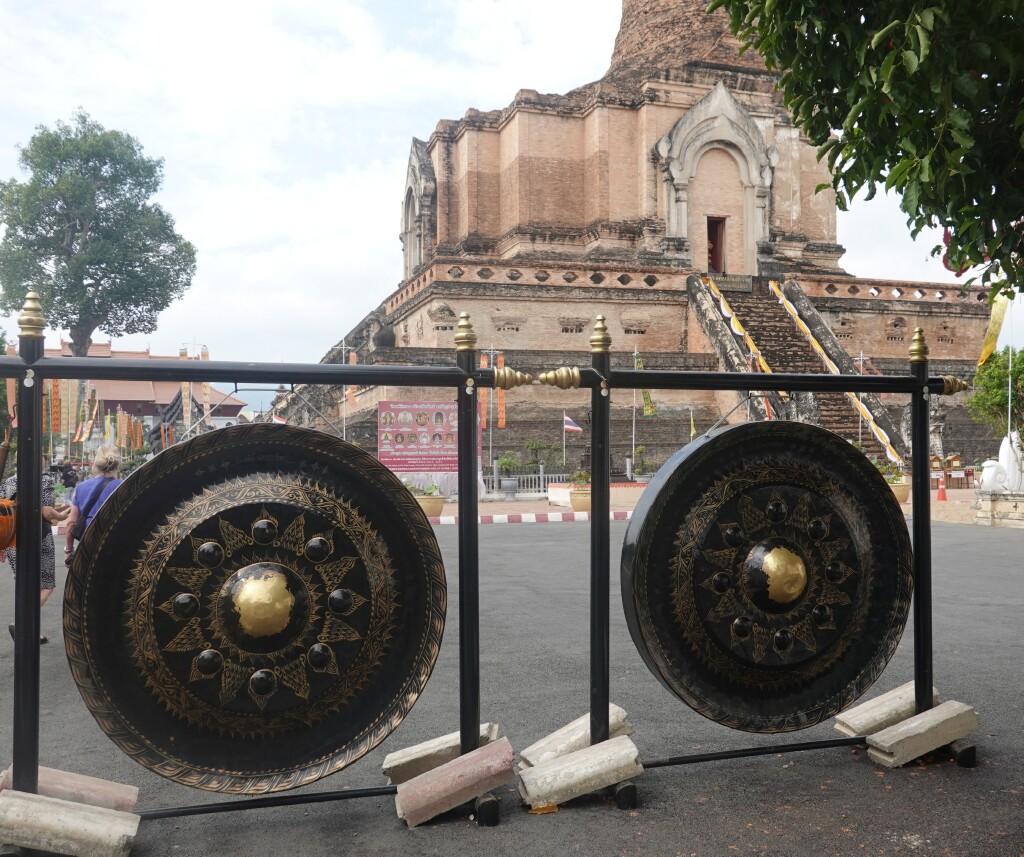
Phra That Chedi Luang
Standing behind the viharn looking at the large chedi, there is an elegance and a feeling of strength and solidity to this structure, even though damaged. I have been told that it is left unrestored because it is not known nor documented how the top 30 meters looked before the earthquake, and to restore it improperly would bring great dishonor.
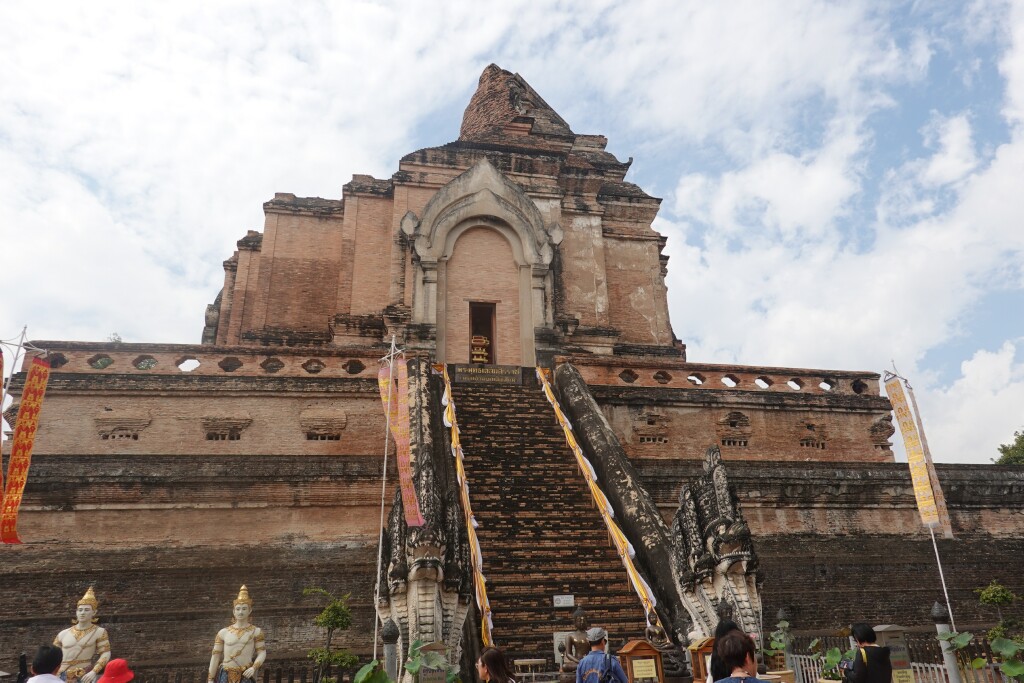
In 1991 a black jade Buddha image called “Phra Phutta Chalerm Siritat” was made and installed on the barely visible gold-colored stand in the niche above the stairs where the Emerald Buddha once sat. This was made to celebrate three auspicious anniversaries: the 700th anniversary of Chiang Mai, the 600th anniversary of Wat Chedi Luang, and the 50th anniversary of the King’s accession to the throne. [That was King Bumibol Adulyadej or King Rama IX, the ninth King of the Chakri Dynasty, who passed away in 2016.]
At the base of the chedi almost in front of me when I took the photo above are these two new statues of what appear to be ancient warriors. There are four of these statues, two on either side of the stairway. The two not shown below and slightly visible in the photo above are male while the two below are a male and a female. I could find no information about these new statues or their meaning. Under the male statute, the translation is “in the end of the year.”
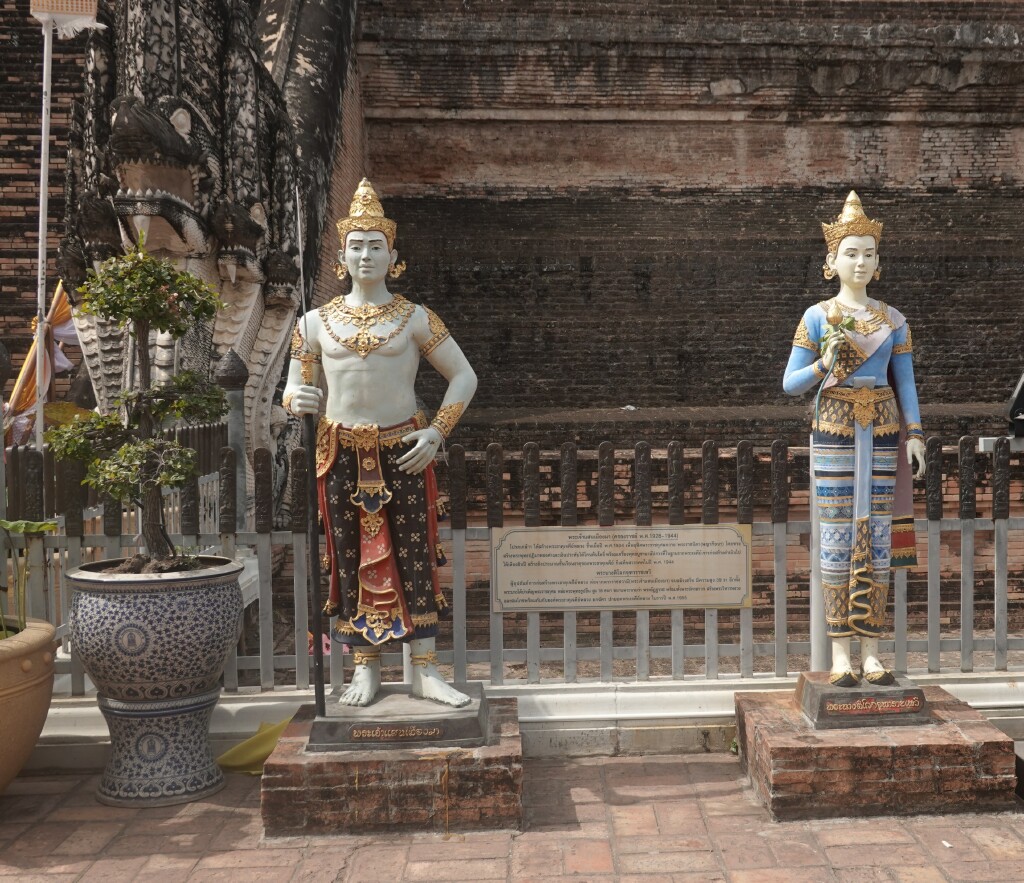
And by this area is what appears to be a fairly large model of what the Phra That Chedi Luang might have looked like. [I’m hoping this is not a model of a planned restoration, but it may be, dispelling what I have been told about restoring and honor.]
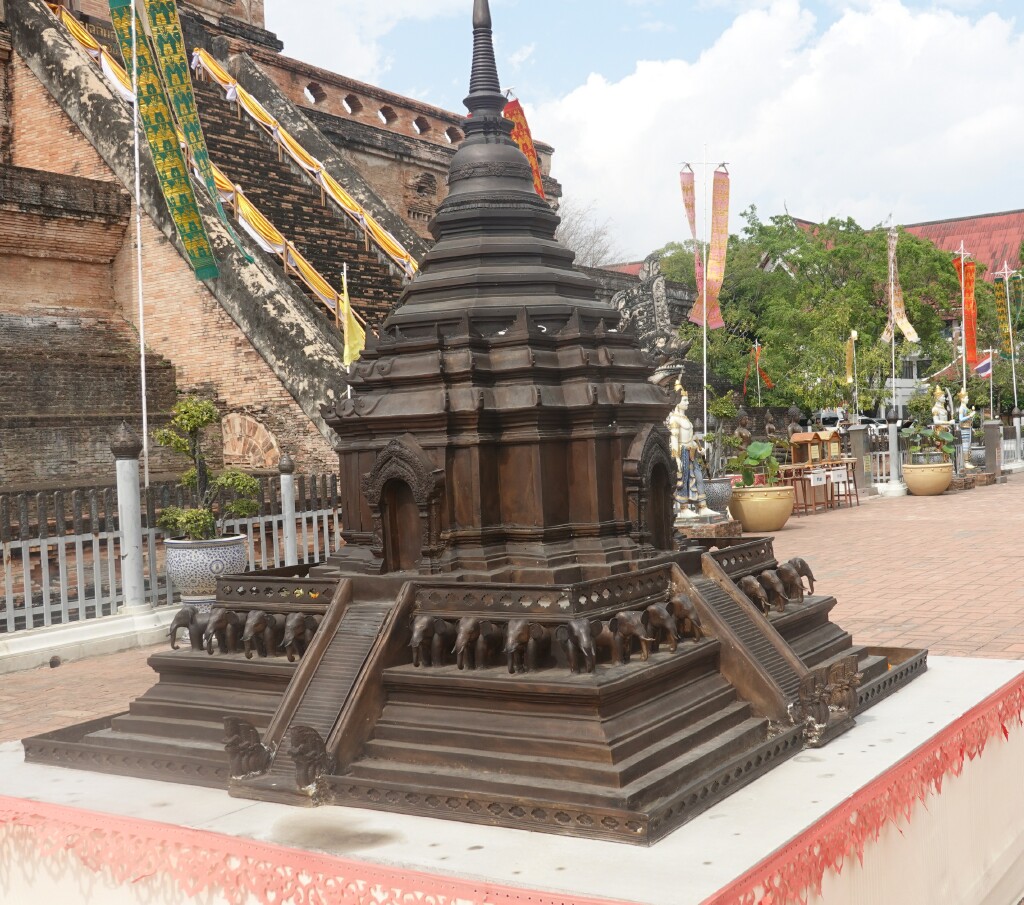
Walking over to the southwest corner of the chedi, I sat where I used to sit for my morning meditation. This photo shows my view of the large, elegant, and strong-looking chedi:
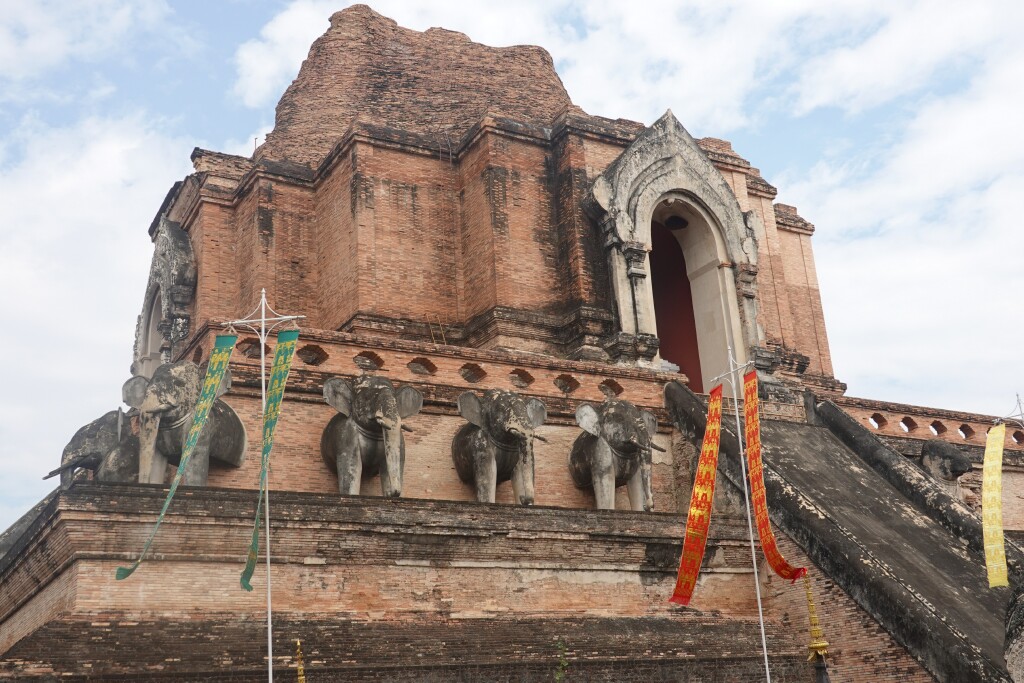
Bhuridatto Viharn
At the southwest corner of the temple grounds is another, much smaller viharn officially called the “Viharn Luangpu Mun Bhuridatto,” named after a highly revered monk and houses many important Buddha relics. This viharn is comparably new, having been built in 1858 during the reign of Prince Chao Kawirorotsuriyawong of the Thip Chang dynasty.
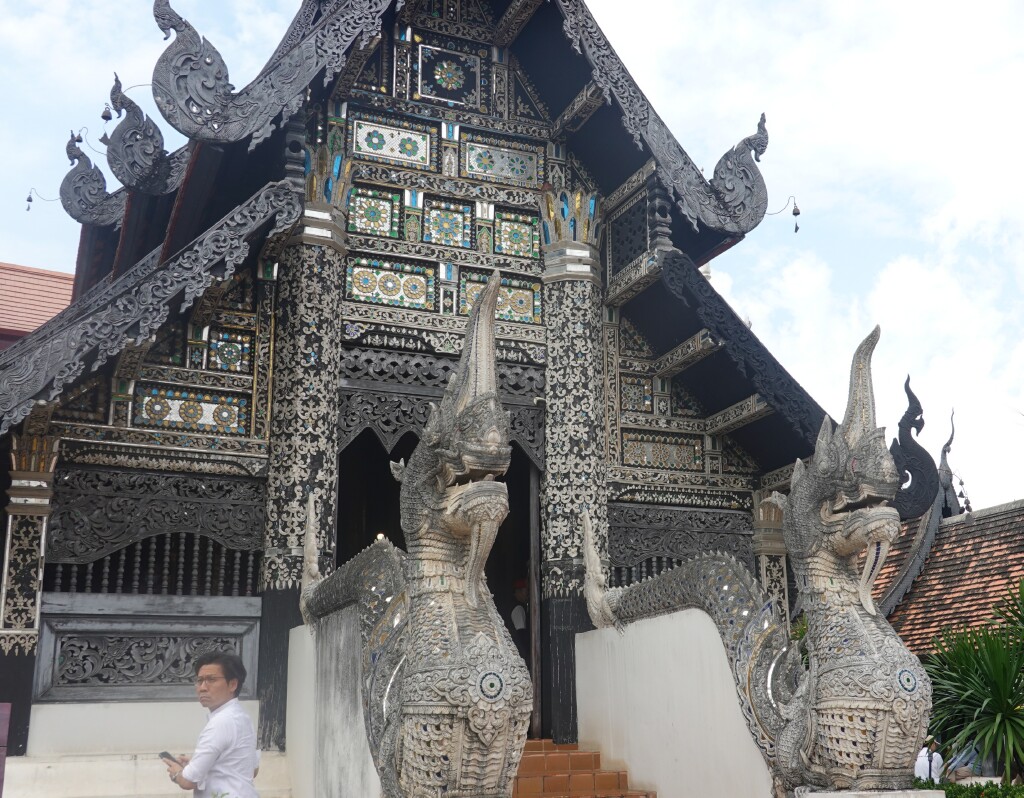
The design is in the pure Lanna style with a triple-tiered overlapping roof, steeply pitched and descending close to the ground. It is said this is to be almost like the wings of a protective bird. The exterior is dark lacquered teak adorned with intricately carved floral motifs highlighted by different colored pieces of glass.
There are another two small viharns that house Buddha relics and remains of venerable monks including an image in wax of one of these revered monks. I passed on these structures – too eerie for my taste or interest.
Recent Buddha Pavilions
There are two structures or small pavilions I always stop to see. They contain Buddha images (statues) that were carved in the Chiang Rai area north of Chiang Mai using stone quarried near there. When these were brought by truck to Wat Chedi Luang, I happened to be at my morning meditation when they unloaded the images from the trucks onto pedestals that had been built. It was a lengthy process. Later the pavilion structures were built around the statues.
The first is the Phra Buddhamani-Srilanna Buddha image. It’s said to be made in the Singsuang style, in the meditation mudra, and is nearly 4 meters high (13 feet) and weighs over 10 tons.
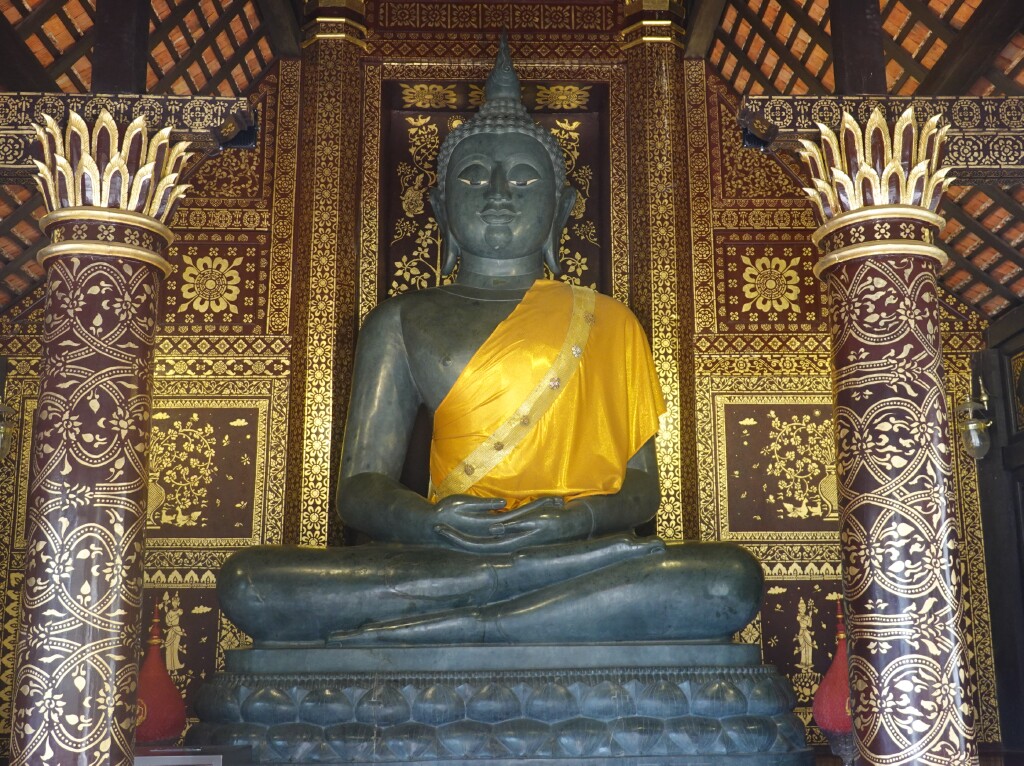
The second is the Phra Buddharatana-Naganaphisi Buddha image. This is three and a half meters high, and weighs 15 tons. The Buddha seated in the meditation mudra is protected by the five-headed naga serpent.
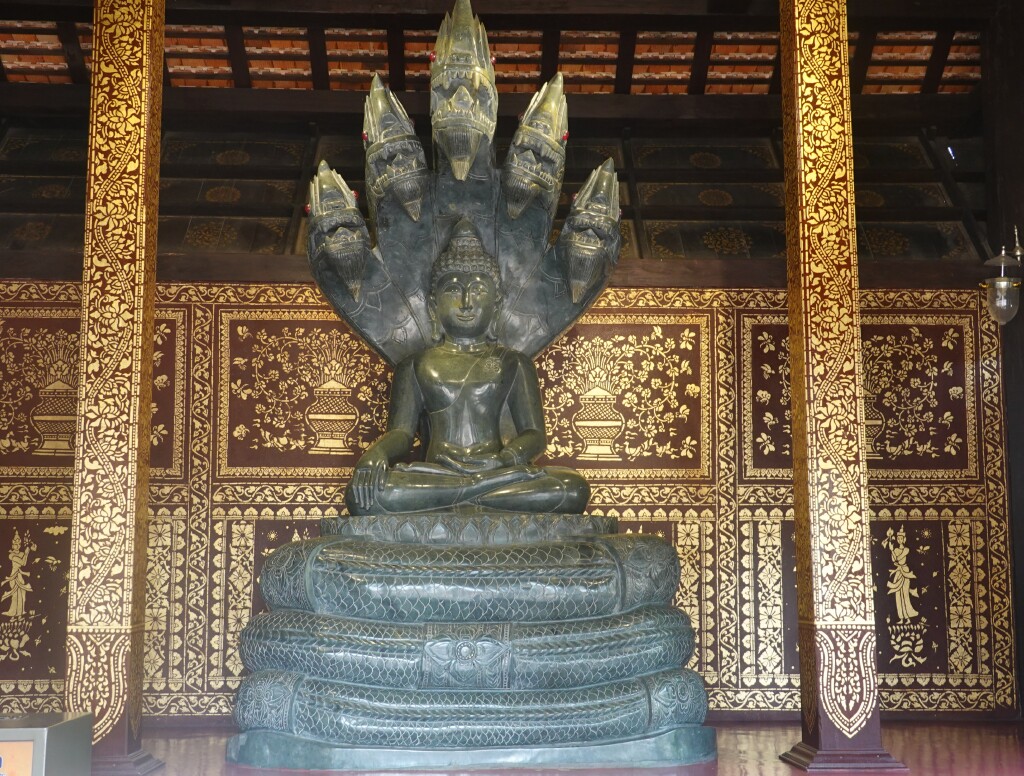
Ho Trai and Museum
On the north of the large chedi is the Ho Trai, or library of Buddhist and temple documents. It is also a museum, and I have visited many times. The museum has received royal patronage and proudly shows photographs of their visits. The museum is very well curated with detailed labeling of exhibits in both Thai and English. The short stairway to the ho trai is protected by mom (pronounced like moam) creatures as is typical of many if not most ho trai I have seen.

Walking back towards the main entrance, I could see that the construction on the north side of the large viharn is not as complete as that on the south side. The roof is done. Last year the workers were replacing the entire roof, so there was much more scaffolding.
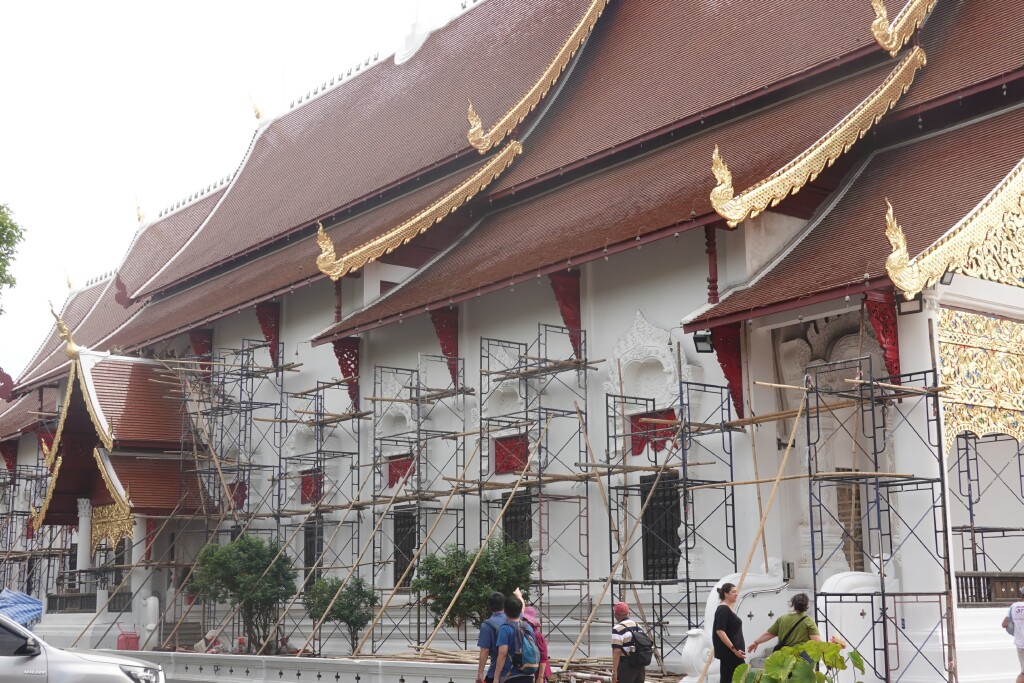
Near the entrance, I looked back to see the small north chedi, the viharn, and the large chedi in the background.
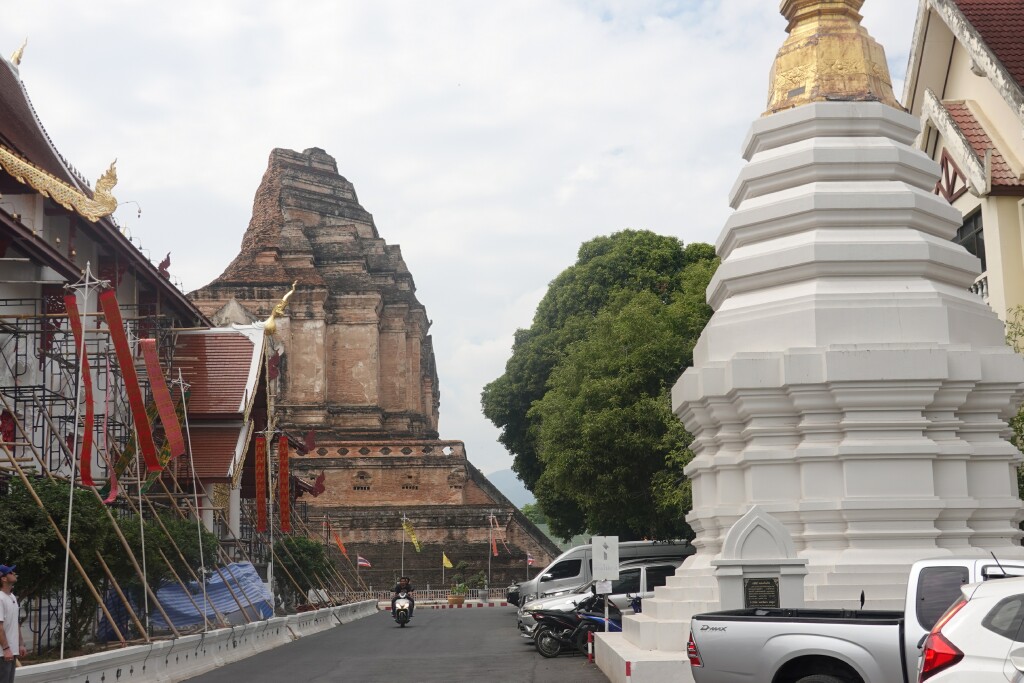
I do love Wat Chedi Luang. I suspect that when I return in November it will be fully open and I’ll share pictures of the inside and the large standing Buddha.
Next: Traveling home and reflections on my eleventh winter in Chiang Mai